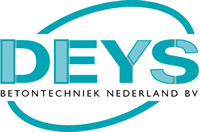 |
Deys Betontechniek Nederland BV Gelreweg 5, 3843 AN Harderwijk Postbus 330, 3840 AH Harderwijk http://www.deys.nl Telephone +31 (0)341 41 51 48 (24 hr / day) Fax (0341) 42 54 90 info@deys.nl |
BETOCHEM 3200
| Description |
|---|
BETOCHEM 3200 extra fine is a two-component levelling mortar free of solvents based on high-grade epoxy resin. |
| Quality control |
|---|
During manufacturing only raw materials of high quality are used which amply meet the strictest requirements. During the production process as well as during the final stages these materials are extensively tested for quality in our own laboratory. |
| Application areas |
|---|
|
²²²÷≥≥
| Packaging and storage |
|---|
| 5 kg – In the original properly closed packaging in a cool dry place, frost free minimum storage life 12 months. |
| Precautions |
|---|
| Refer to the information on the packaging of the product, safety sheets and processing advice C. |
| Application |
|---|
| By means of a trowel etc. For thixotroping the material BETOCHEM thickener can be added; dosage depends on the application, but will generally amount to 50 gram per 5 kg set. Thickener is added when the layer thickness is 10 mm, depending on the temperature. Tools can be cleaned with BETOCHEM brush dilutant EP. |
| Ground |
|---|
| Concrete, other cement-bound and stone-like grounds and steel. The ground should be clean, dry and free of dust, grease and dirt and furthermore should meet the terms and conditions that normally apply. Metal grounds should be freed of corrosion products and a primer should be applied if so required. |
| Resistance to chemicals |
|---|
| Refer to list of resistance to chemicals. |
| Article Code | 3200 extra fine |
|---|---|
| Colour | concrete grey (RAL colour on demand) |
| Density [kg/dm³] (20°C) | 1.9 |
| Amount to be used [kg/m²] (1 cm thickness of layer) | 22 |
| Thickness of layer (cm) | 5 at the maximum |
| Solid content (percentage by volume) | 100 |
| Mixing ratio (by part of weight) | |
| • Component A | 92.2 |
| • Component B | 7.8 |
| Flash point [°C](DIN 53213) | |
| • Component A | > 100 |
| • Component B | > 100 |
| Potlife [min] (20°C) | approx. 45 |
| Processing temperature [°C] | 5-35 |
| Drying/full-hardening (20°C/65% RH/3 cm thickness of layer) | |
| dust-dry | after approx. 4 hours |
| repaintable | after approx. 16 hours |
| ready to be walked on | after approx. 16 hours |
| (in system building or with several layers, a maximum drying time of 24 hours between layers applies, unless a pre-treatment of the surface has occured) | |
| Compressive strength [N/mm²] 28 days | 85 |
| After 1 day [N/mm²] | 45 |
| After 7 days [N/mm²] | 80 |
| Flexural-tensile strength [N/mm²](20°C) | 45 |
| E-module [N/mm²] | 2950 |
| Shear strength [N/mm²] | 30 |
| Tensile strength [N/mm²] | 16 |
| Linear expansion coefficient (5K1) | 3.5 x 10 |
| Adhesion strength [N/mm²] | ≥ 4 |
| Exothermic behaviour [°C] | approx. 15 above processing temperature |
| H.D.T. [°C] | 70 |
| Processing advice |
|---|
General Processing Advice Synthetic materials [C]Ground Processing time (Potlife) Mixing Preliminary treatment Application Tools Industrial hygiene |
Liability
The technical instructions and recommendations we provide on the basis of our experience and to the best of our knowledge, are entirely without obligation and merely provide an indication. Not all facts, problems and queries that occur during practical application can be included in a general documentation sheet. Our recommendations and instructions do not commit us to any legal obligations as a result of the purchase and application of our products. Any deviating agreements made by our employees that are not included in our datasheets will only be lawful providing they have been confirmed in writing by the management. Our raw materials, semi-finished products and products comply with the most stringent quality standards. This does not relieve the user of their responsibility to test our products prior to their application. Our general trading and delivery conditions, which we are happy to forward to you on demand, are and remain applicable at all times.
This specification sheet supersedes any previous versions.